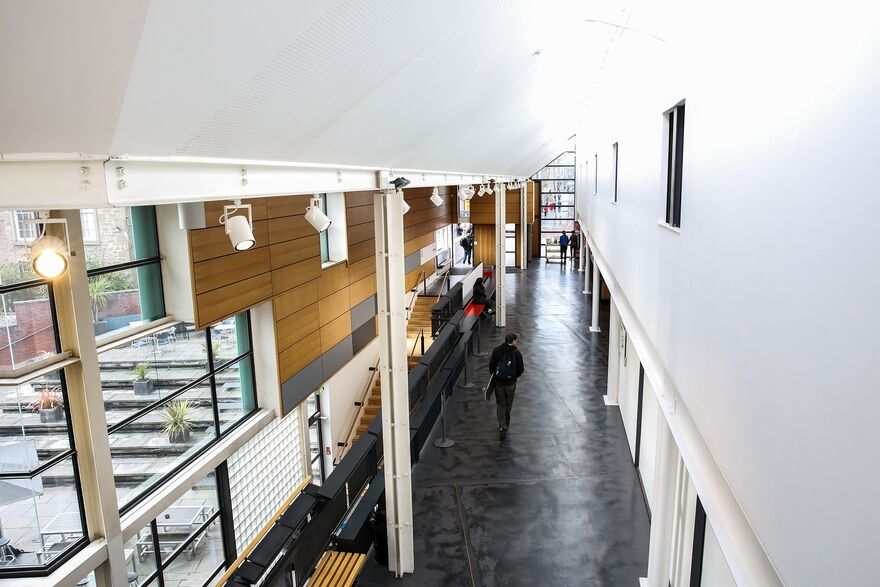
Claudia Martínez Garay
Every seed is awakened
24 August - 17 November 2024
We were delighted to present the first solo exhibition in Scotland from artist Claudia Martínez Garay.
Claudia Martínez Garay is a Peruvian artist who lives and works between Amsterdam and Lima. Martínez Garay's practice encompasses painting, sculpture, printmaking, video, and site-specific installation. As well as interrogating European museum collections and histories, Martínez Garay also takes inspiration from her own Andean heritage, exploring historical images, propaganda, and sounds from her home country. Her sculptural works frequently reference pre-Columbian knowledge systems and are often combined in larger installations in dialogue with symbolic elements derived from her research.
For this major new solo exhibition at DCA, Martínez Garay brought together existing works alongside three new commissions, two of which were created during a production residency in DCA Print Studio. The artist’s other commission is sculptural, featuring bold graphic sublimated prints onto aluminium which stood in 3-D against a mural designed for DCA.
Installed across Gallery 1 was the artist’s video animation Ayataki, which weaved together socio-political history in the aftermath of the 1980s Peruvian internal conflict between the Shining Path guerrillas and the military. This conflict led to forced disappearances, and the mass displacement and migration of families from rural to urban living environments. The film’s backdrop, a reconstructed landscape, references both the repercussions of civil struggle and the reality of vast migrations of people. It featured the constant presence of a radio tower: these were often targeted during the war to limit communications through the country, and are now seen as a symbol of that era.
The accompanying soundscape combines original music written by the artist alongside audio samples ranging from traditional songs from the Peruvian Andes to sound footage from the 1970 documentary El terremoto de Áncash (The Ancash Earthquake). There is also occasional dialogue spoken in Spanish and Quechua, a group of languages spoken by the indigenous Quechua peoples of South America. Combined, the animation and sound create an atmospheric installation, with layers of history and civil unrest hauntingly brought to the fore.

Gallery 2 featured the artist’s newly-commissioned works, alongside a bold, graphic painted mural and a suite of tuftings. These textiles were part of the artist’s ongoing Pacha series: conceived in 2020, the series is named after the Quechua concept Pacha that is the undivided unity of time and space in Andean Cosmovision. It also references the cyclical nature of time among the Cosmovision’s three domains, spanning the past, present and future; and its three planes: upperworld, present world and the underworld. Each work brings together a constellation of symbols and motifs from the natural and mythical worlds such as caves, mountains, light, and rainbows. Just as the Pachas series brings together history and the present, the artist has described the manner in which she works through installation and multiple works as enabling her to encompass the complex Andean cosmology and the diversity of inhabitants throughout history in Peru. In doing so, her work shifts between different historical moments, allowing her to relate to and learn from history.
Lastly, the artist’s installation ¡Kachkaniraqkun! / ¡Somos aún! / ¡We are, still! (2018) was reconfigured for DCA, following its exhibition at the 21st Contemporary Art Biennial Sesc_Videobrasil, São Paulo (2019). Martínez Garay combined standing murals, geometric forms, and ceramic works to reflect on the idea of multiple temporalities and ideologies, which pass through same land, invoking a strong identification with indigenous cultures. The artist created this installation as part of an ongoing process of inquiry into the life of cultural artifacts, how they are created, preserved and circulated.
Supported by




Claudia Martínez Garay: Exhibition Notes
Audio Resources
To listen to our Exhibition Notes, please click here.
To listen to visual describer Juliana Capes's descriptions of Every seed is awakened, please click here.
You can also access the audio Exhibition Notes and audio descriptions on Bloomberg Connects.







